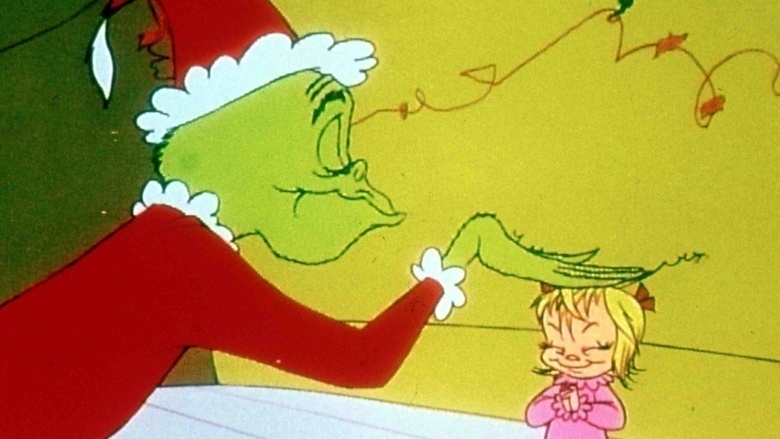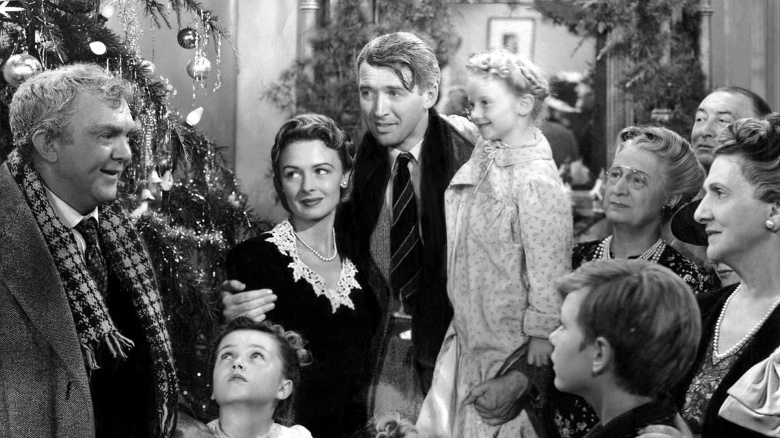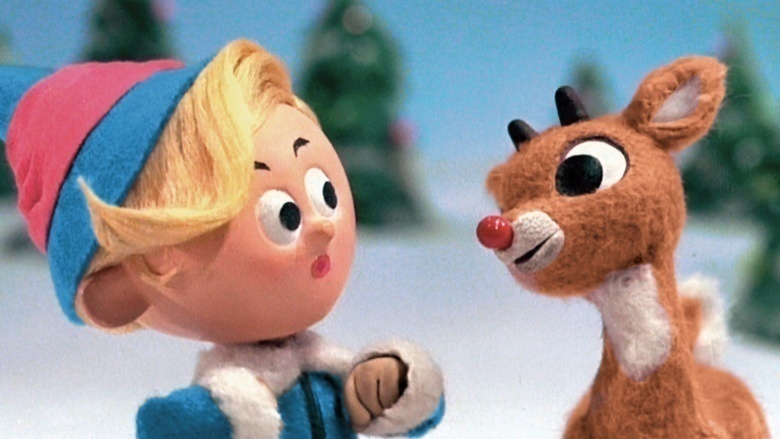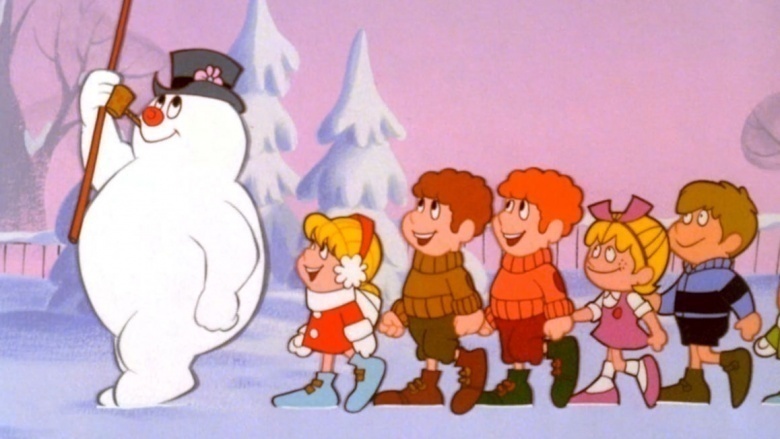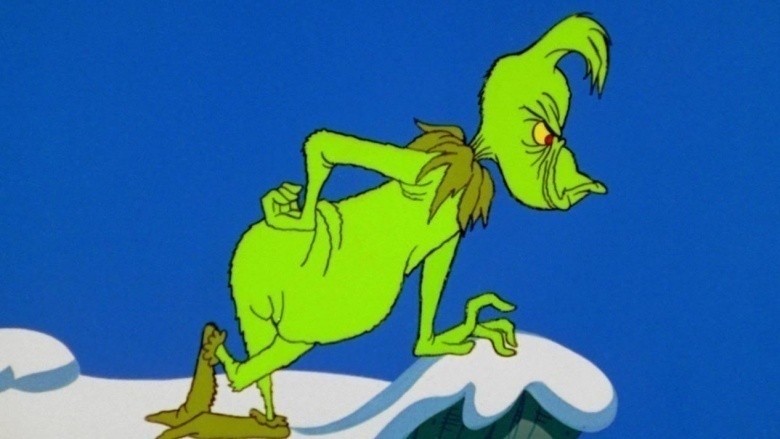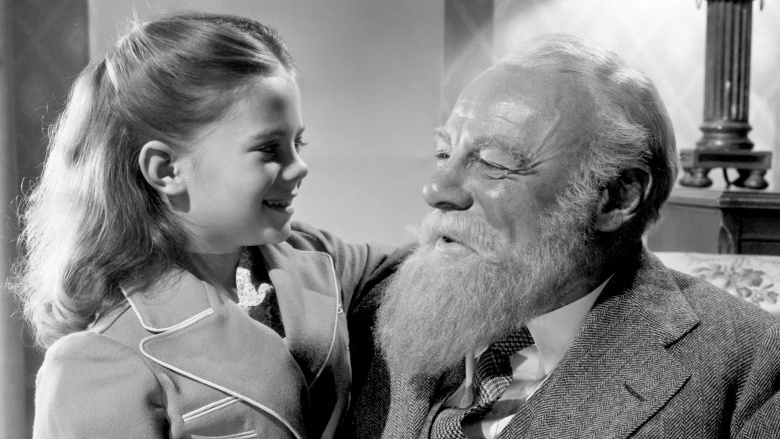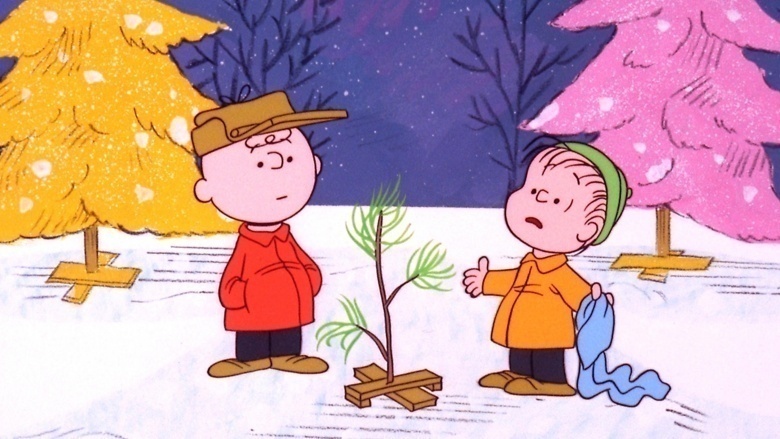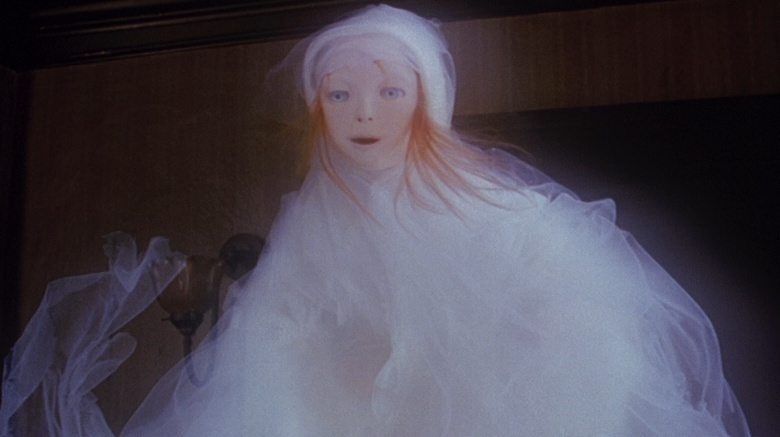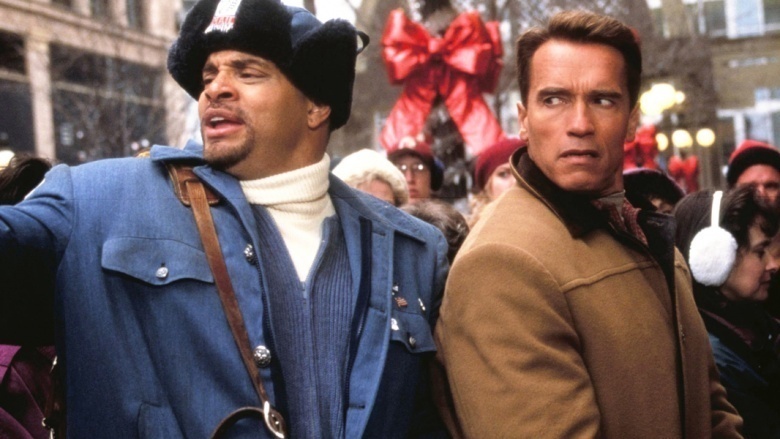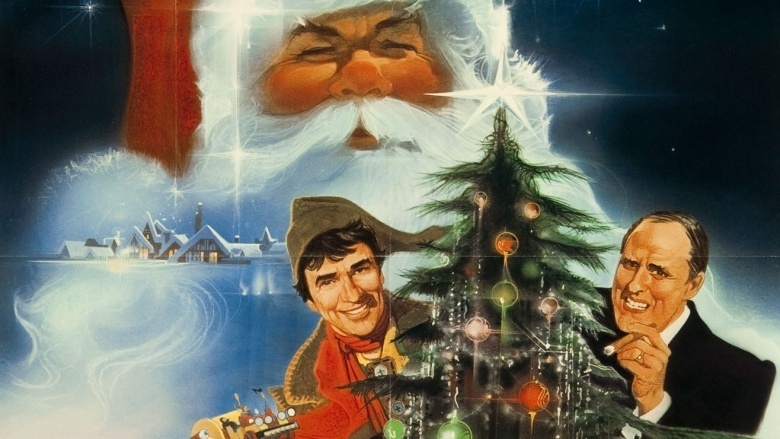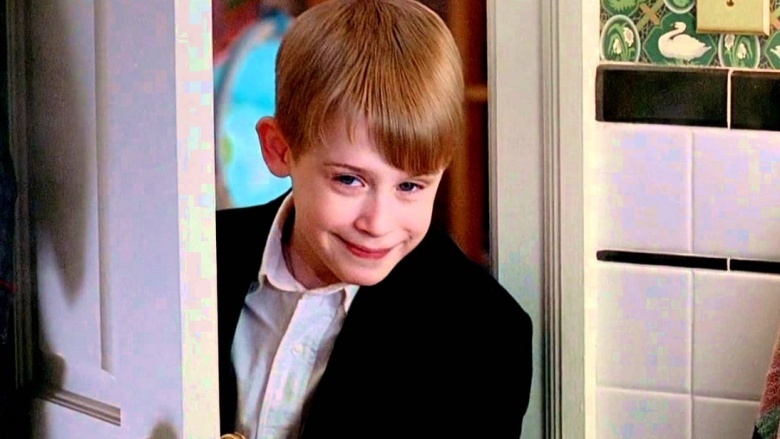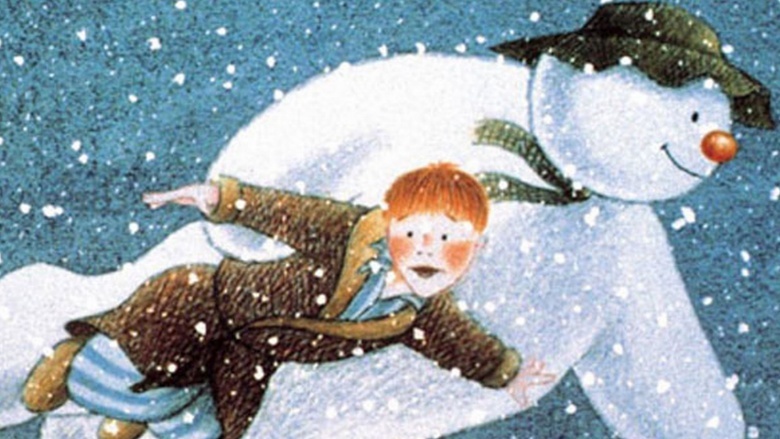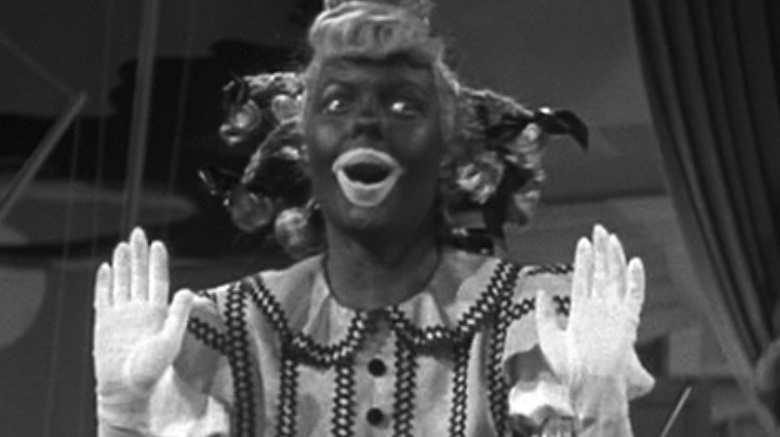Creepy Things You Never Noticed In Classic Christmas Movies
Even television programmers take the holidays off, scheduling marathons and blocks of reruns that now thankfully include modern classics like Die Hard, Home Alone, and A Christmas Story. But these new additions haven't replaced the old standards—Frosty, Rudolph, the Grinch, and more. We loved them as kids and continue to accept them as hallmarks of the holiday season. But there is definitely questionable stuff going down in some of these. Here's a list of the creepy things you never noticed from classic Christmas movies.
It's a Wonderful Life (1946)
Suicide, sudden death by stroke, housing projects—they're all here for this joyful holiday tale!
But what's really creepy is the method that George Bailey's guardian angel uses to change George's mind about killing himself. (Again, Merry Christmas!) He pretends to drown, forcing George to jump in and save him, just as he had to do as a boy when his brother, Harry, fell through a frozen lake. This is the accident that costs George the hearing in one of his ears, and arguably started the chain of events that trapped him in Bedford Falls for his entire life.
We don't even have to get into how Harry is a total jerk, whose wealthy father-in-law, college education, and hero military status all probably could have done something to help the George's business, but don't. Apparently having a wonderful life is all about not realizing it until you're at your absolute breaking point, upon which holy intervention is your only hope. That's a clear message you want to send to anyone struggling with hopeless despair.
Rudolph, the Red-Nosed Reindeer (1964)
This one probably has the biggest creep factor, and not just because of the gruesome revenge dentistry scene in which Hermey extracts the passed-out Bumble's teeth, although that would probably be enough. For starters, Rudolph's dad, Donner, responds to his son's birth defect (that very shiny nose) by encouraging him to cover it up and lie about it to fit in. Great message, dad. This obviously backfires in Rudolph's face and sets in motion the entire story, which is one of self-imposed exile and mortal danger. You know, Christmas-y stuff.
It also teaches kids about hostile workplaces like the one fostered by the head elf who berates and taunts Hermey in front of everyone for his admittedly weird dream of becoming a dentist. Just fun, light holiday themes all around here. And as if all of that wasn't enough, remember the Bumble we mentioned? Well, after his horrifying oral injury, they throw him off a cliff, along with the story's hero, Yukon Cornelius, who returns at the end with the now docile Bumble, who's presumably been tortured into being some kind of zombie pet. Are we entirely sure they weren't writing a Halloween movie and just missed the deadline by a few months?
Frosty the Snowman (1969)
This wonderful tale starts when a seemingly drunk, terrible magician, Professor Hinkle, spectacularly fails during a magic show that the children's teacher inexplicably hired him to perform on the day before Christmas. There are a million questions about that, but what's truly creepy in this movie is how the whole story hinges on the fact that these kids stole this man's magic hat.
Yes, we're aware that he had given up and was going to throw the hat away, but he never got the chance, because his backstabbing, red-eyed rabbit took off, leaving Hinkle to get trampled by the children as they ran outside. As he runs after them to fetch his rabbit and hat, that's when he sees Frosty come to life, and Hinkle realizes the potential of his—key word his—magical hat. The crime is so obvious that the narrator steps in to try to convince the audience otherwise, but we don't buy it. Is a man not entitled to change his mind? Sure, Hinkle goes on to literally murder Frosty in front of Karen, but how would you feel if someone stole a winning lottery ticket out your hand at the exact moment you realized you hit the jackpot?
How the Grinch Stole Christmas! (1966)
We could point out the blatant canine abuse of poor little Max, the Grinch's dog who's mercilessly whipped and forced into doing the labor of a pack mule, or the fact that the Whos seem to be weird cat-people creatures who also have insect-like antennae. And is Cindy Lou Who an amputee? The imagery is all over the place, but the creepiest thing is how the story undermines its whole morality at the end.
Think about it. What is the Grinch's grand gesture after executing his theft to make a statement against the materialist excess of the holiday? He rides into Whoville like a hero and gives it all back! He rewards them for not caring about material things by giving them back all of their material things. That's like a judge sentencing a pot dealer to a vacation in Amsterdam. We're not really sure the message got through there.
Miracle on 34th Street (1947)
Most of this movie is so completely ridiculous, you have to just laugh at the silliness of it all. A real world trial over the true identity of Santa Claus? Come on. But there is one moment—when Kris Kringle actually beats the Macy's personnel counselor in the head with his cane—that's shocking not only because of the inappropriate violence, but also because it takes place in front of a group of kids. "Were you all good little boys and girls this year?" "Yes, Santa, we swear it, just please not in the face!" And wait, what kind of a department store is regularly psychoanalyzing its employees anyway? This movie is even weirder than we thought.
A Charlie Brown Christmas (1965)
The whole symbol of the Christmas spirit in A Charlie Brown Christmas is Charlie's sad little tree. You know, the one that the other kids hate and mock until they dress it up with Snoopy's lights and ornaments? This, for some reason, makes Charlie Brown happy despite that fact that he was previously disgusted by the exact adornments when they were on Snoopy's doghouse, because they represented the commercialization of Christmas.
Not to mention, the Viking and Egyptian use of evergreen boughs and palm branches to worship various gods predated the Christian use of the tree for thousands of years. So, when the kids could care less about Christmas until they make the tree beautiful with store-bought goods, they're basically engaging in pagan nature worship with a little capitalism tossed into the mix. Did we mention the whole special was commissioned and broadcast on behalf of the Coca-Cola Corporation? But that's not really relevant, because that's a company that's never made a dime off of selling Christmas, right?
The Muppet Christmas Carol (1992)
One of countless adaptations of Charles Dickens' classic novel, Brian Henson's The Muppet Christmas Carol stars Michael Caine as eternal skinflint and all-around jerk Ebeneezer Scrooge opposite Kermit the Frog as his well-meaning employee Bob Cratchit. While jammed full of all the slapstick hijinks that fans of Jim Henson's furry creations have come to expect, the story actually remains true to the source material for the most part, with Scrooge visited by three yuletide spirits who proceed to show him the error of his stingy ways. The Ghost of Christmas Present is a jolly red-bearded giant who never stops chuckling, the perfect time travel companion, and the Ghost of Christmas Future is his usual black-hooded self, nothing unusual there. Henson's take on the Ghost of Christmas Past, however, is nothing short of terrifying.
The first of the three spirits to visit Scrooge on the night of Christmas Eve, this glowing specter is straight out of a Japanese horror movie. When he pulls back the curtains on his lavish four-poster bed, the unbelieving Scrooge is met with a floating, semi-transparent child who addresses him in an equally as creepy high-pitched voice. In reality, even the hardest of men would have done as they were told at this point and allowed the other two ghosts a night off.
Jingle All the Way (1996)
A divisive holiday classic, but a classic nonetheless, Jingle All the Way follows Arnold Schwarzenegger's absurd attempts to procure a Turboman action figure, the must-have gift for young boys everywhere that particular Christmas, for his son. Having forgotten to pick the toy up when asked to do so by his wife, Arnie is forced to throw himself headfirst into the madness of last-minute Christmas shopping, and the muscle-bound suburbanite gets into his fair share of scrapes along the way. The wheels of his car get jacked, he has to put up with an annoying postman (whatever happened to Sinbad, anyway?) half the time, and his neighbor is constantly trying to put the moves on his wife. His lowest moment of all, however, comes when he's assaulted by a pack of vicious mothers.
Arnie's hunt for Turboman takes him to a toy store where a raffle is being held to decide who will get to take home the few remaining dolls. A scuffle for the numbered balls ensues, and Schwarzenegger ends up following one into a ball pool. Unfortunately for him, a kid playing in the pool gets to it first and decides to put it in his mouth. The desperate dad grabs the child by the cheeks before he can swallow, but the next thing he knows he is being set about by a handbag-wielding mob of moms, berating him for being a "pervert" and adding an uncomfortable air to a previously harmless scene.
Santa Claus: The Movie (1985)
Another Christmas movie that failed to win over the critics but went on to become an annual cult tradition anyway, Santa Claus: The Movie is a garish blend of tinsel, product placement and chain-smoking. The title suggests that this film (produced by the father-son Salkind team that brought us Superman: The Movie) was designed to be the definitive Santa Claus flick, and it comes complete with an origin story explaining just where Old Saint Nick got the powers that allow him to fly around the world in a single night—though, despite a festive start, it suffers from jarring tonal shifts caused largely by unscrupulous toymaker B.Z. (John Lithgow).
B.Z. is in trouble with the Senate for stuffing his teddy bears with rusty nails, used razor blades and shards of glass, so when Santa's former helper Patch comes along with an idea to mass-produce candy canes that make children fly, the cigar-puffing business mogul sees it as a chance to bounce back. Huggable toy bears stuffed with objects that will take a eye out in an instant is a pretty creepy thought in itself, though B.Z. maxes out the creepometer when 10-year-old Joe discovers that his new range of candy canes causes explosions. Instead of recalling the items, he locks Joe in the basement of his factory and plans to flee to Brazil, leaving the orphan boy to starve in the dark.
Home Alone 2 (1992)
There's a lot of questionable parenting going on in the first two Home Alone movies, though it is Kevin McCallister's relationship with his uncle that comes across as being particularly odd. The constantly cranky Frank seems to have a real stick up his butt when it comes to young Kevin, unleashing the now-classic burn "look what you did, you little jerk" after he accidentally spills some milk. Kevin's uncle also seems to take great pleasure in his humiliation at the hands of his big brother in the Christmas pageant, howling with laughter as Buzz uses candlesticks to air-drum on his head during his big vocal solo. His constant passive-aggressive behavior doesn't make Kevin shy, however. Quite the opposite, in fact.
Before Kevin accidentally jets off to New York by himself in Home Alone 2, he gets in some practice with his trusty Talkboy, a handheld recording device that ends up saving his bacon on more than one occasion. One particular recording that comes in handy is the one he makes of his uncle Frank singing. Nothing creepy about that, right? Except that Frank was scrubbing his naked body in the shower at the time. In Kevin's defense, he only went into the occupied bathroom after being encouraged to do so by his parents, making the scene that little bit creepier. Frank's response ("get out of here, you nosy little pervert, or I'm going to slap you silly") is, for once, appropriate.
The Snowman (1982)
English author Raymond Briggs' The Snowman was published in 1978 and became a part of Christmas tradition in Britain, where a 26-minute animated adaptation has been aired by Channel 4 every year since 1982. Like the book, the Oscar-nominated short is completely wordless (except for the famous accompanying song "Walking in the Air"), adding an air of creepiness to this story of a boy spirited away by a snowman he builds on Christmas Eve. The creepiness was fully intended if you believe the author, who felt that the adaptation actually didn't have enough of it.
Briggs revealed that The Snowman is really about death, and bemoaned the fact that the adaptation made it all about Christmas. The visit to the North Pole and meeting with Santa Claus were not part of Briggs' original tale, the point of which was to teach kids about mortality through the melting of the titular snowman. While the animators did reduce said snowman to a puddle as per the source material, they softened the blow by letting the boy find a scarf from Santa in his pocket, betraying Briggs' original ending—which the author himself described as "Clean, nice and silent. I don't have happy endings."
Holiday Inn (1942)
This festive musical gave birth to a timeless holiday singalong in "White Christmas," a song written by Irving Berlin as part of a script containing 12 original numbers—not all of which would go on to be remembered quite as fondly. Despite reviews at the time declaring that Holiday Inn's music "never commits a breach of taste," those of us watching it back over our Christmas pudding today probably wouldn't agree with that assessment, especially after seeing the cast perform a song called "Abraham." This number is a celebration of President Lincoln's birthday by the African-American performers at the Holiday Inn variety club—at least, that's what it appears to be at first glance. It quickly becomes apparent that the man leading the number isn't black...but actually Bing Crosby covered in facepaint.
Also appearing in blackface is Marjorie Reynolds, who gave a performance that was equally as offensive as her co-star's, but a hell of a lot creepier. With "minstrel show" white paint ridiculously slapped across her mouth, Reynolds sings about Honest Abe with a terrifying wide-eyed grin as extras in black makeup play instruments and serve the all-white audience. Ironically, the only genuinely black performer in this creepy ode to civil freedoms sings her part from a kitchen, completely separate from the film's blacked-up stars. Her verse (the only part of the number that doesn't leave your face sore from all the cringing) was simply edited in later.
